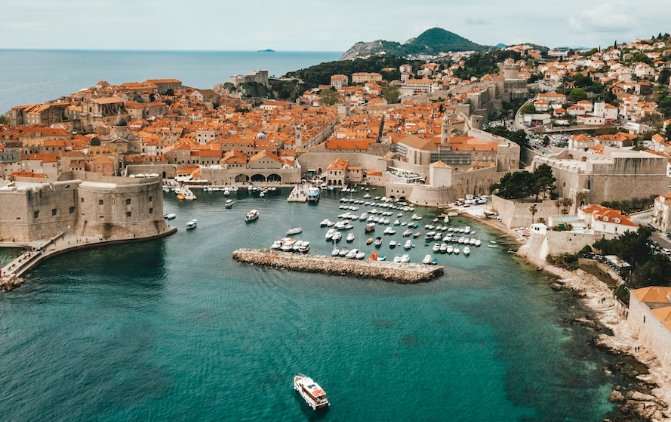Le Mans: A Travel Guide to the Racing Capital of France

Visit a Real-Life Sugar Mill on a Vermont Maple Syrup Tour
March 7, 2025
Best U.S. Cities to Celebrate Oktoberfest in Munich
March 13, 2025Le Mans is no stranger to celebrity faces. Brad Pitt, Patrick Demsey and Keanu Reeves have all competed in the flagship motorsport endurance race of the 24 Hours of Le Mans. Leonardo DiCaprio’s 1998 film The Man in the Iron Mask was filmed in this well-preserved medieval city. Recently, Christian Bale and Matt Damon were in town filming Ford vs. Ferrari. However, this humble riverside city between Normandy and the Loire Valley in France still goes unnoticed by most tourists.
In 2023, Le Mans will celebrate the centenary of the 24 Hours, but take some time to explore the city beyond the star-studded sporting event. You’ll stumble upon architectural gems, alleys on Instagram, and a vibrant street art scene based on fascinating British and French history.

What to do
Back to the Middle Ages
At first glance, Le Mans’ modern city center may seem nothing special, but stroll into the medieval Plantagenet City and you’ll reach for your camera at every turn. It’s easy to imagine yourself in a medieval movie setting as you explore the crowding of sloping cobbled alleys and steep stairs and various half-timbered and brick facades.
Maison du Pilier Rouge offers an English-speaking guided walking tour (every Wednesday, June to August, €6), which showcases architectural details and historical context that you might otherwise miss. Highlights include the remains of the majestic Gallo-Roman walls and towers, the magnificent St. Julian’s Basilica, and the hanging house waving a cute teddy bear outside the window. History buffs take note: Le Mans is home to Henry II, the first king of the Plantagenet dynasty, and Berengaria, the mysterious wife of Richard the Lionheart, and your guide will undoubtedly tell you the story of the British and French royal families.
Indulge your inner speed demon
Motorsport is the lifeblood of Le Mans, and even if you can’t tell the difference between Ferrari and Mazda, it’s hard not to soak up the excitement. If you can’t attend the big events – the annual events June 6 Hours of Le Mans and the biennial 24 Hours of Le Mans Le Mans Classic – visit the Le Mans Museum 24 hours open to get up close and personal with the race, you can even visit the famous track (museum only: 24 euros; Plus track 10 euros).
The museum houses 120 vintage cars and cutting-edge sports cars, all kept running, the most notable of which are the 1924 Bentley (the first Le Mans champion in 1923) and a Toyota TS 050, still stained with mud at the time of its triumph. There is also an impressive collection of miniature cars, which includes all 1923,2022 cars that competed in the 24 Hours of Le Mans from 4 to 500.
Highly recommended guided tours (from 12 euros), who are well versed not only in car trivia and technical specifications, but also in anecdotes about racing days and American movie stars. In 2023, the museum will undergo major changes: a special centennial exhibition will be held, and an ambitious expansion project will be launched at the end of the year.
Meditate in nature
Just a short tram or bike ride from the city center, the Royal Abbey of Épo (admission €5.50) has played an important role in the Anglo-French history of Le Mans. The building was created in 1230 by Queen Navarre’s Berengaria of Navarre, who spent the rest of her life here after her husband’s death. Visit her tomb displayed in the magnificent monastery church, then see the humble monks’ quarters and wander the monastery grounds and vegetable garden, where open-air concerts, photo exhibitions, and other events are held throughout the year.
The monastery is located on the 500-hectare edge of L’Arche de la Nature, where forest trails and lakes offer plenty of respite from city life. Maison de la Prairie offers farm tours and horse-drawn carriage tours, and you can also rent bicycles and canoes from Maison de l’Eau.

Check out the street art scene
The annual Le Mans Street Art Extravaganza celebrates the Plein Champ Street Art Festival in July in the Gué du Maulny Park, with some works on display throughout the year (use this interactive map to find them). Rent a bike and ride along the scenic cycle paths along the Salte and Huysín rivers, stopping along the way to admire the ever-changing murals of the Ancienne Usine des Tabacs (old tobacco factory).
Where to stay
The most stylish place to stay overnight is the Le Prince Hotel & Spa, with its huge king-size bed and ambient lighting for a deep sleep. If you need extra relaxation help, the spa features a jacuzzi, sauna, Turkish bath, and offers a variety of massages and treatments. Double room from 110 EUR; Breakfast 15 euros.
For a more intimate atmosphere, Le Henri IV is a family-run mansion set in a beautifully renovated 18th-century townhouse at the foot of Plantagenet. Each of the five rooms has its own character with plush carpets, unique artwork and plenty of natural light, while breakfast is served in the luxurious dining room. If booked direct, double rooms start from EUR 100 and breakfast costs EUR 12.
For something a little different, stay at one of the eco-lodges Domaine de L’Epau, a 15-minute drive from the city center. Inspired by the natural surroundings, each room features spacious, modern interiors, a kitchenette, terrace and a breakfast basket on your windowsill every morning. The heated outdoor pool with waterfall, forest views and an adjoining sauna and Turkish bath was an added bonus. Low season double room with breakfast from 95 EUR; High price 150 euros.
Where to eat
Le Mans has everything from fine dining restaurants to lovely tea houses, but double-check the opening hours – many are closed on Sundays and Mondays, and some are only open for weekday lunch. A favorite for lunchtime is the trendy L’Étage restaurant, tucked away above the Librairie Doucet bookstore, inspired by the truck of the dining car Mami. For afternoon tea (called goûter in French), you can’t go wrong with a glass of foamy cappuccino and a piece of homemade cake in the charming restaurant. Lechudlon de Salem.
When night falls, book a table at Bistrot des Gourmets for amazing cuisine at affordable prices, or head to the welcoming restaurant L’Épi Curieux for an innovative twist on local specialties and seasonal dishes. Out of town, Le Verger serves traditional French cuisine from local farmers.
Where to drink
Plantagenet has a special atmosphere after dark (just watch out for your footsteps on the cobblestones) and there are plenty of lively bars. Head to Le Lapin Blanc for a delicious cocktail in cozy and cool surroundings, or Le Saint-Flaceau housed in a quirky old mansion with a “blink of an eye” sign in front.
In the modern center, Le 108 is the preferred meeting place for the city’s 20-somethings, while La Visitation, a former monastery courtyard that has been converted into an entertainment center, features several restaurants and bars, as well as an open-air stage for concerts in the summer.
Or would you like to see local ideas at Le Mans? A must-have for craft beer lovers is La Septante-Deux, the city’s first urban microbrewery, while Distillerie du Sonneur produces 100% local water for life, liqueurs and gins with some rather unexpected flavors. The latter offers guided tours of live wineries, tastings and workshops (from €6).

Where to shop
All shopping streets in the modern center of Le Mans lead to Place de la République, where you can find all the usual shopping street brands as well as some of the best local goods. Olaf & Gustave specializes in handmade jewelry, women’s clothing and accessories, and is located in nearby Broc’angerie, which is half teahouse and half antique shop. Comic book lovers will definitely want to check out Librairie Bulle, which has a bookstore and art gallery, while foodies can find Chocolaterie Bellanger (24-hour themed chocolates are a fun choice for petrol fans) and Biscuiterie La Sablésienne, both local specialties.
The cobbled avenues of Plantagenet City are filled with artisan workshops, antique shops and music shops, while the Au Coeur des Artistes brings together gifts and handicrafts from more than 20 local artisans.
Architectural highlights
Saint-Julian’s Cathedral, one of the largest cathedrals in France, blends five centuries of Gothic and Romanesque styles to dramatic effect. The highlight is the 34-metre-high arched choir with 108 bay windows – the rose-colored glass creates a dazzling brightness that changes throughout the day.
Getting there
Try to fly less? Perfect – Le Mans has no airport anyway. Le Mans can be reached in about four hours by train from London. You can take the Eurostar to the Gare du Nord (2 hours 16 minutes), the metro to Montparnasse-Bienvenue (20 minutes) and the TGV direct train to Le Mans (54 minutes). Or, if you don’t want to go through the hassle of taking the Paris Metro, take the Eurostar to Lille Europe station (1 hour 22 minutes) and then take the direct TGV to Le Mans (2 hours 37 minutes). The nearest ferry port is Caen, about 1 hour and 45 minutes drive from Le Mans.

FAQs
What currency do they use?
- Euro.
What language do they speak?
- French.
How much should I tip?
- Tipping is not required, but a tip of 5% to 10% is appreciated.
What is the time difference?
- GMT +1.
How should I get around/what is the status of public transport?
- The only way to explore Plantagenet is on foot, but to explore further, take the bus tram or rent a bike, Brico Cycle (€15 per day, e-bike €25 per day).
What’s the best view?
- From July to September, stroll around the Cité Plantagenêt in the evening and admire the city’s dazzling lights “Chimères Night”.



